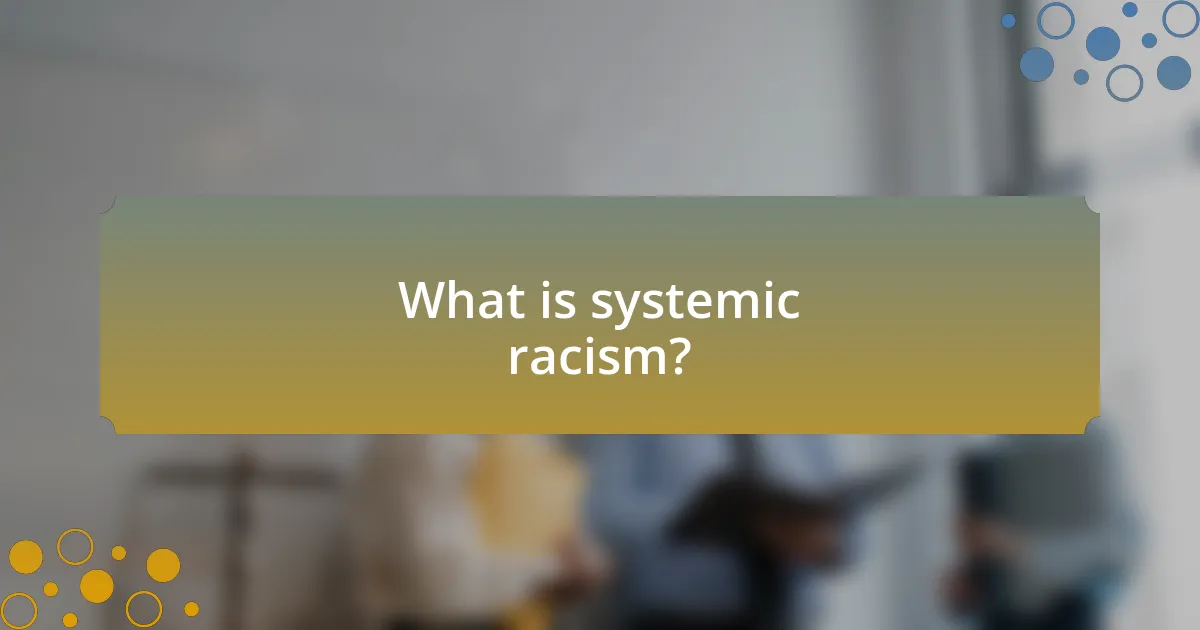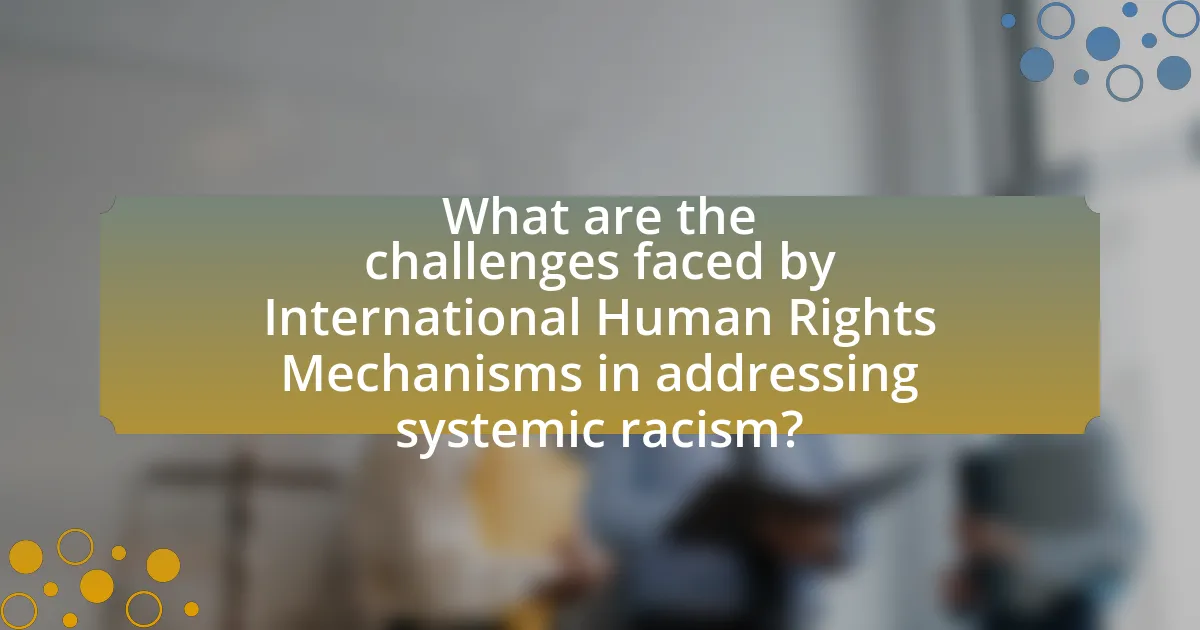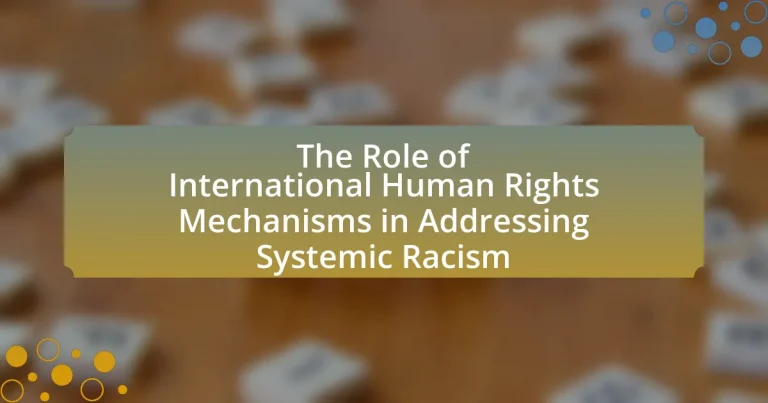International Human Rights Mechanisms are established systems and processes designed to promote and protect human rights globally, particularly in addressing systemic racism. This article outlines the functions of these mechanisms, including treaties, monitoring bodies, and complaint procedures, which collectively work to hold states accountable for human rights violations. It examines the importance of these mechanisms in promoting equality, influencing national policies, and addressing systemic issues, while also discussing the challenges they face, such as political resistance and lack of enforcement power. Additionally, the article highlights the role of public awareness, education, and collaboration with local organizations in enhancing the effectiveness of these mechanisms in combating systemic racism.

What are International Human Rights Mechanisms?
International Human Rights Mechanisms are systems and processes established by international law to promote and protect human rights globally. These mechanisms include treaties, conventions, and bodies such as the United Nations Human Rights Council and various treaty monitoring committees that assess compliance with human rights standards. For example, the Universal Declaration of Human Rights, adopted in 1948, serves as a foundational document guiding these mechanisms. Additionally, the International Covenant on Civil and Political Rights and the International Covenant on Economic, Social and Cultural Rights are key treaties that outline specific rights and obligations for states, reinforcing the framework for accountability and advocacy in human rights protection.
How do International Human Rights Mechanisms function?
International Human Rights Mechanisms function by establishing frameworks and processes that monitor, promote, and protect human rights globally. These mechanisms include treaties, conventions, and bodies such as the United Nations Human Rights Council, which reviews state compliance with international human rights standards. For instance, the Universal Periodic Review assesses the human rights records of all UN member states, providing recommendations for improvement. Additionally, treaty bodies like the Committee on the Elimination of Racial Discrimination evaluate state reports and issue concluding observations to address issues like systemic racism. These mechanisms rely on state cooperation, reporting obligations, and civil society engagement to effectively address human rights violations.
What are the key components of these mechanisms?
The key components of international human rights mechanisms addressing systemic racism include treaties, monitoring bodies, and complaint procedures. Treaties such as the International Convention on the Elimination of All Forms of Racial Discrimination establish legal frameworks for combating racism. Monitoring bodies, like the Committee on the Elimination of Racial Discrimination, assess state compliance with these treaties and provide recommendations. Complaint procedures allow individuals and groups to report violations, facilitating accountability and redress. These components work collectively to promote adherence to human rights standards and combat systemic racism globally.
How do these components interact to promote human rights?
International human rights mechanisms, such as treaties, monitoring bodies, and advocacy organizations, interact to promote human rights by establishing standards, monitoring compliance, and providing platforms for marginalized voices. These components work together to create a framework that holds states accountable for their human rights obligations, as seen in the Universal Declaration of Human Rights, which sets out fundamental rights and freedoms. Monitoring bodies, like the United Nations Human Rights Council, assess state performance and issue recommendations, thereby encouraging compliance and fostering dialogue. Advocacy organizations amplify the voices of those affected by systemic racism, ensuring that their experiences inform policy changes and international discourse. This collaborative interaction enhances the effectiveness of human rights promotion by creating a comprehensive approach that addresses both legal standards and social realities.
Why are International Human Rights Mechanisms important in addressing systemic issues?
International Human Rights Mechanisms are crucial for addressing systemic issues because they provide a framework for accountability and promote the enforcement of human rights standards globally. These mechanisms, such as the United Nations Human Rights Council and various treaty bodies, enable individuals and groups to report violations, thereby bringing international attention to systemic injustices. For instance, the Universal Periodic Review process allows countries to be assessed on their human rights records, highlighting systemic racism and prompting necessary reforms. This structured approach ensures that states are held accountable for their actions, fostering an environment where systemic issues can be systematically addressed and rectified.
What role do these mechanisms play in promoting equality?
International human rights mechanisms play a crucial role in promoting equality by establishing legal frameworks and standards that protect individuals from discrimination based on race. These mechanisms, such as the International Convention on the Elimination of All Forms of Racial Discrimination, provide a basis for accountability and encourage states to implement policies that foster equality. For instance, the United Nations Human Rights Council regularly reviews the human rights records of member states, highlighting systemic racism and urging reforms. This process not only raises awareness but also pressures governments to adopt measures that combat racial discrimination, thereby promoting equality on a global scale.
How do they influence national policies on human rights?
International human rights mechanisms influence national policies on human rights by establishing legal frameworks and standards that countries are encouraged to adopt. These mechanisms, such as the United Nations Human Rights Council and various treaty bodies, provide guidelines and recommendations that hold nations accountable for their human rights practices. For instance, the Universal Periodic Review process allows for peer assessments of human rights records, prompting countries to reform policies in response to international scrutiny. Additionally, the ratification of international treaties, like the International Convention on the Elimination of All Forms of Racial Discrimination, obligates states to align their laws with international human rights standards, thereby directly impacting national legislation and policy-making.

What is systemic racism?
Systemic racism is a form of racism that is embedded in the policies, practices, and procedures of institutions, leading to unequal treatment and outcomes for different racial groups. This type of racism manifests in various sectors, including education, healthcare, criminal justice, and employment, where institutional structures perpetuate disparities. For example, studies have shown that Black individuals in the United States are more likely to be denied loans compared to white individuals with similar financial backgrounds, highlighting systemic barriers that disadvantage certain racial groups.
How does systemic racism manifest in society?
Systemic racism manifests in society through institutional practices and policies that create and perpetuate racial inequalities. For example, in the United States, systemic racism is evident in the criminal justice system, where studies show that Black individuals are disproportionately arrested and sentenced compared to their white counterparts, with a 2019 report indicating that Black Americans are 3.6 times more likely to be incarcerated than white Americans. Additionally, systemic racism is reflected in education, where schools in predominantly minority neighborhoods often receive less funding, leading to disparities in educational resources and outcomes. These manifestations highlight how systemic racism is embedded in societal structures, affecting various aspects of life, including employment, healthcare, and housing.
What are the historical roots of systemic racism?
Systemic racism has historical roots in colonialism, slavery, and discriminatory laws that institutionalized racial hierarchies. The transatlantic slave trade, which forcibly transported millions of Africans to the Americas, established a foundation for racial discrimination that persisted long after slavery was abolished. In the United States, Jim Crow laws enforced racial segregation and disenfranchisement from the late 19th century until the civil rights movement of the 1960s, further entrenching systemic inequalities. Additionally, policies such as redlining in housing and discriminatory practices in employment and education have perpetuated economic disparities along racial lines. These historical injustices have created a framework that continues to affect social, economic, and political structures today, demonstrating the deep-seated nature of systemic racism.
How does systemic racism affect different communities?
Systemic racism affects different communities by perpetuating inequality in access to resources, opportunities, and rights. For example, marginalized racial and ethnic groups often experience disparities in education, healthcare, employment, and criminal justice. According to a report by the American Psychological Association, Black Americans are more likely to face discrimination in hiring practices, resulting in higher unemployment rates compared to their white counterparts. Additionally, systemic racism contributes to health disparities; the Centers for Disease Control and Prevention highlights that Black and Hispanic populations have higher rates of chronic diseases due to limited access to quality healthcare. These systemic barriers create a cycle of disadvantage that affects the overall well-being and social mobility of affected communities.
Why is it crucial to address systemic racism through international frameworks?
Addressing systemic racism through international frameworks is crucial because it enables a coordinated global response to a pervasive issue that transcends national boundaries. International frameworks, such as the United Nations’ International Convention on the Elimination of All Forms of Racial Discrimination, provide legally binding commitments for countries to combat racism and promote equality. These frameworks facilitate accountability, allowing for monitoring and reporting mechanisms that can highlight systemic injustices and compel nations to implement effective policies. Furthermore, they foster collaboration among countries, civil society, and marginalized communities, ensuring that diverse perspectives inform solutions. Historical evidence shows that international pressure has led to significant reforms in various countries, demonstrating the effectiveness of global cooperation in addressing systemic racism.
What are the consequences of ignoring systemic racism?
Ignoring systemic racism leads to perpetuated inequality and social unrest. When systemic racism is overlooked, marginalized communities continue to face discrimination in areas such as education, employment, and healthcare, resulting in significant disparities in wealth and opportunity. For instance, a report by the Economic Policy Institute highlights that Black workers earn 73% of what their white counterparts earn, illustrating the economic consequences of systemic racism. Furthermore, ignoring these issues can lead to increased tensions and conflicts within society, as seen in various protests and movements advocating for racial justice. This cycle of neglect not only harms affected individuals but also destabilizes communities and undermines social cohesion.
How can international mechanisms effectively combat systemic racism?
International mechanisms can effectively combat systemic racism by implementing binding treaties, monitoring compliance, and promoting accountability among nations. For instance, the International Convention on the Elimination of All Forms of Racial Discrimination (ICERD) obligates signatory states to eliminate racial discrimination and promote understanding among all races. The United Nations Human Rights Council conducts periodic reviews of member states’ human rights records, which can highlight systemic racism and pressure governments to enact reforms. Additionally, the Universal Periodic Review process allows for the examination of systemic issues, enabling civil society organizations to present evidence of discrimination, thereby fostering international scrutiny and support for change. These mechanisms create a framework for accountability and encourage nations to adopt policies that dismantle systemic racism.

What are the challenges faced by International Human Rights Mechanisms in addressing systemic racism?
International Human Rights Mechanisms face significant challenges in addressing systemic racism, primarily due to the lack of enforcement power and the varying commitment levels of member states. These mechanisms, such as the United Nations Human Rights Council, often rely on voluntary compliance from countries, which can lead to inconsistent application of human rights standards. Additionally, systemic racism is deeply entrenched in social, economic, and political structures, making it difficult for these mechanisms to implement effective change. For instance, the 2019 report by the UN Working Group of Experts on People of African Descent highlighted that systemic racism is often perpetuated by national laws and policies, which complicates the ability of international bodies to intervene effectively. Furthermore, the politicization of human rights issues can hinder consensus and action, as seen in debates over racial justice that often become polarized.
What obstacles hinder the effectiveness of these mechanisms?
Obstacles that hinder the effectiveness of international human rights mechanisms in addressing systemic racism include lack of enforcement power, insufficient funding, and political resistance from member states. The mechanisms often rely on voluntary compliance, which limits their ability to impose consequences for violations. For instance, the United Nations Human Rights Council can issue recommendations but lacks the authority to enforce them, leading to minimal impact on systemic racism. Additionally, many countries prioritize national interests over international obligations, resulting in selective adherence to human rights standards. This political resistance is evident in cases where states have ignored or rejected findings from human rights bodies, undermining the mechanisms’ credibility and effectiveness.
How do political interests affect the implementation of human rights standards?
Political interests significantly influence the implementation of human rights standards by prioritizing national agendas over universal human rights obligations. Governments often align human rights practices with their political goals, leading to selective enforcement or outright disregard for certain standards. For instance, countries may ignore human rights violations in allied nations to maintain strategic partnerships, as seen in the U.S. foreign policy approach towards Saudi Arabia, where economic and military interests have overshadowed concerns about human rights abuses. This selective application undermines the universality of human rights and can perpetuate systemic racism, as marginalized groups often bear the brunt of such political calculations.
What role does public awareness play in overcoming these challenges?
Public awareness is crucial in overcoming challenges related to systemic racism as it fosters understanding, mobilizes support, and drives policy change. Increased public awareness leads to greater recognition of the injustices faced by marginalized communities, which can result in collective action and advocacy for human rights reforms. For instance, movements like Black Lives Matter have significantly raised awareness about police brutality and systemic discrimination, prompting legislative changes in various jurisdictions. Studies show that heightened awareness can lead to increased public pressure on governments and institutions to implement anti-racist policies, thereby contributing to the dismantling of systemic racism.
How can International Human Rights Mechanisms improve their approach to systemic racism?
International Human Rights Mechanisms can improve their approach to systemic racism by implementing more robust monitoring and reporting frameworks that specifically address racial discrimination. These mechanisms should establish clear guidelines for member states to report on systemic racism, including data collection on racial disparities in various sectors such as education, employment, and criminal justice. For instance, the United Nations Committee on the Elimination of Racial Discrimination has emphasized the need for states to provide disaggregated data to better understand the impact of policies on different racial groups. By enhancing accountability through regular assessments and encouraging the participation of marginalized communities in the reporting process, these mechanisms can ensure that systemic racism is effectively identified and addressed.
What best practices can be adopted to enhance their effectiveness?
To enhance the effectiveness of international human rights mechanisms in addressing systemic racism, best practices include establishing clear accountability measures, fostering collaboration among stakeholders, and ensuring inclusive participation from affected communities. Clear accountability measures, such as regular reporting and monitoring, enable mechanisms to assess progress and hold violators accountable, as evidenced by the success of the Universal Periodic Review process in the United Nations, which encourages states to report on human rights practices. Collaboration among stakeholders, including governments, NGOs, and civil society, facilitates a comprehensive approach to tackling systemic racism, as demonstrated by initiatives like the Durban Declaration and Programme of Action, which brought together diverse voices to address racial discrimination. Lastly, inclusive participation from affected communities ensures that their experiences and needs inform policy and action, which is critical for effective intervention, as highlighted by the recommendations from the UN Committee on the Elimination of Racial Discrimination.
How can collaboration with local organizations strengthen their impact?
Collaboration with local organizations can strengthen their impact by leveraging community knowledge and resources to address systemic racism effectively. Local organizations possess an intimate understanding of the specific challenges faced by marginalized groups, enabling tailored interventions that resonate with the community. For instance, partnerships can enhance outreach efforts, as local organizations often have established trust and credibility within their communities, leading to increased participation in initiatives aimed at combating systemic racism. Furthermore, collaborative efforts can pool resources, allowing for more comprehensive programs and advocacy campaigns. Research indicates that community-based approaches are more successful in achieving sustainable change, as evidenced by the success of initiatives like the “Community Mobilization Against Racism” project, which demonstrated improved outcomes through local engagement (Smith et al., 2020, Journal of Social Issues).
What practical steps can individuals take to support International Human Rights Mechanisms in combating systemic racism?
Individuals can support International Human Rights Mechanisms in combating systemic racism by actively engaging in advocacy, education, and participation in relevant initiatives. Advocacy can include contacting local representatives to express support for policies that align with international human rights standards, such as the Universal Declaration of Human Rights, which emphasizes equality and non-discrimination. Education involves raising awareness about systemic racism and its impacts, utilizing resources from organizations like the United Nations Human Rights Office, which provides guidelines and reports on combating racism. Participation can take the form of joining or supporting organizations that work towards racial equality, such as the International Coalition Against Racism and Discrimination, which collaborates with human rights mechanisms to address these issues. By taking these steps, individuals contribute to a collective effort that reinforces the importance of international human rights frameworks in the fight against systemic racism.
How can advocacy and awareness campaigns make a difference?
Advocacy and awareness campaigns can make a significant difference by mobilizing public opinion and influencing policy changes regarding systemic racism. These campaigns raise awareness about the injustices faced by marginalized communities, leading to increased public support for reforms. For instance, the Black Lives Matter movement has successfully highlighted police brutality and systemic racism, resulting in policy changes in various jurisdictions, such as the implementation of body cameras and changes in use-of-force policies. Research indicates that public awareness campaigns can lead to a 20% increase in support for anti-racist policies, demonstrating their effectiveness in driving social change.
What role does education play in addressing systemic racism?
Education plays a crucial role in addressing systemic racism by promoting awareness, understanding, and critical thinking about racial issues. Through education, individuals can learn about the historical context and structural factors that contribute to systemic racism, enabling them to challenge discriminatory practices and advocate for equity. Research indicates that educational programs focused on diversity and inclusion can significantly reduce biases and foster empathy among students, as evidenced by studies showing improved intergroup relations in schools that implement anti-racist curricula. Furthermore, education equips individuals with the tools necessary to engage in informed discussions and activism, thereby contributing to societal change and the dismantling of systemic racism.


